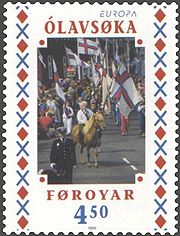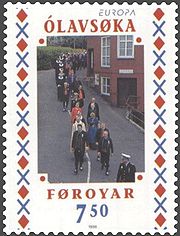
Ólavsøka
Encyclopedia


Public holiday
A public holiday, national holiday or legal holiday is a holiday generally established by law and is usually a non-working day during the year....
of the Faroe Islands
Faroe Islands
The Faroe Islands are an island group situated between the Norwegian Sea and the North Atlantic Ocean, approximately halfway between Scotland and Iceland. The Faroe Islands are a self-governing territory within the Kingdom of Denmark, along with Denmark proper and Greenland...
, celebrated on July 29. It is the day when Løgting
Løgting
Løgting is the unicameral parliament of the Faroe Islands, a self-ruling dependency of Denmark.The name literally means "Law Thing" - that is, a law assembly - and derives from Old Norse lǫgþing, which was a name given to ancient assemblies. A ting or Þing has existed on the Faroe Islands for over...
, the Faroese Parliament, opens its session.
The literal meaning is “Saint Olaf’s Wake
Wake (ceremony)
A wake is a ceremony associated with death. Traditionally, a wake takes place in the house of the deceased, with the body present; however, modern wakes are often performed at a funeral home. In the United States and Canada it is synonymous with a viewing...
” (vigilia sancti Olavi in Latin), from Saint Olaf’s death at the Battle of Stiklestad
Battle of Stiklestad
The Battle of Stiklestad in 1030 is one of the most famous battles in the history of Norway. In this battle, King Olaf II of Norway was killed. He was later canonized...
in 1030 (see Olsok
Olsok
Olsok is now the Norwegian name for 29 July, traditionally the date of the death of King Olaf II Haraldsson of Norway in the Battle of Stiklestad, east of Nidaros , Norway, in 1030...
), but the Løgting
Løgting
Løgting is the unicameral parliament of the Faroe Islands, a self-ruling dependency of Denmark.The name literally means "Law Thing" - that is, a law assembly - and derives from Old Norse lǫgþing, which was a name given to ancient assemblies. A ting or Þing has existed on the Faroe Islands for over...
predates this event. Like several other Faroese holidays, the vøka begins the evening before, so Ólavsøka always starts on July 28 with an opening ceremony.
Ólavsøka is the day of the year when many Faroese crowd into the capital Tórshavn
Tórshavn
Tórshavn is the capital and largest town of the Faroe Islands. It is located in the southern part on the east coast of Streymoy. To the north west of the town lies the high mountain Húsareyn, and to the southwest, the high Kirkjubøreyn...
. There the national rowing
Sport rowing
Rowing is a sport in which athletes race against each other on rivers, on lakes or on the ocean, depending upon the type of race and the discipline. The boats are propelled by the reaction forces on the oar blades as they are pushed against the water...
competition finals are held, which is one of the highlights in Faroese sports. In addition, there are art exhibitions, folk music, and Faroese chaindance
Faroese dance
The Faroese dance is the national chain dance of the Faroe Islands, accompanied by kvæði, the Faroese ballads.The dance is a mediaeval ring dance, which only survived in the Faroe Islands, while in other European countries it was banned by the church, due to its pagan origin...
performances.
The salute for Ólavsøka in Faroese
Faroese language
Faroese , is an Insular Nordic language spoken by 48,000 people in the Faroe Islands and about 25,000 Faroese people in Denmark and elsewhere...
is Góða Ólavsøku! (Good St. Olaf's Wake!).
The stamps shown on the right were issued by Postverk Føroya
Postverk Føroya
Posta is the postal service of the Faroe Islands and was founded on 1 April 1976 under the Home Rule of the Faroe Islands. On 16 December 2005, it became a public joint stock company under the name P/F Postverk Føroya ....
on 18 May 1998, and the artwork was produced by Edward Fuglø.
The Olavsoka concert on 27 July
Some of the festivities start some days before, depending on which day in the week Ólavsøka is. There is usually also an Olavsoka concert in Tórshavn on 27 July in the evening. In 2010 the concert started at 20:00 and ended at around 3 in the morning, according to the schedule.The Olavsoka Eve Procession and Opening on Tinghúsvøllur on 28 July
Normally the opening of Olavsoka starts with a procession of sports people from Tórshavn, city council members, a brass band and people riding on horses. They walk in procession from the public school Kommunuskúlin down to the centre of town to Tinghúsvøllur on Vaglið, where people are waiting for the procession to arrive. The people who walk in procession then gather on the triangle-shaped Tinghúsvøllur in front of the parliament building (Løgtingshúsið og Tinghúsið), there will be a speech by someone who is appointed, and this person will officially open the Ólavsøka. A brass band normally plays at the opening.The Olavsoka Boat Race on 28 July
The Olavsoka Boat Race is always held on the eve of Olavsoka on 28 July. Before the Ólavsøka festival there have been several other village festivals around the islands, where the Faroese boat race has been going on, starting at the Norðoyastevna in KlaksvíkKlaksvík
Klaksvík is the second largest town of the Faroe Islands.The town is located on Borðoy, which is one of the northernmost islands ....
, which is either in the beginning of June or in the end of May. In the end of June there is an island festival in Suðuroy
Suðuroy
Suðuroy is the southernmost of the Faroe Islands. The island covers 163.7 km². In 2010 there were 4763 inhabitants, but there has been a gradual decline in the population numbers ever since the 1950s....
which is called Jóansøka. This festival is celebrated every second year it; is held in Tvøroyri
Tvøroyri
Tvøroyri lies picturesquely on the north side of the Trongisvágsfjørður on the east coast of Suðuroy, Faroe Islands....
(odd years) and every second years in Vágur
Vágur
Vágur meaning Bay is a town on the Faroe Islands of Suðuroy, it is situated on the east coast of the island on the Vágsfjørður fjord, and dates from the fourteenth century. Expansion has meant that the nearby town of Nes is now a suburb of Vágur...
(even years). The rowing competition on Jóansøka is always held on a Saturday. The Faroese boat race is in several parts, divided into groups of children, boys, girls, men and women. The boat races are also grouped by the size of the boats. All the boats are wooden rowing boats, the rowing people are sitting together two and two, and one person is steering the boat in the back of the boat. In Faroese the boats are called 5-mannafør, 6-mannafør, 8-mannafør and 10-mannafør. The boats who win the Olavsoka Boat Race win a trophy and the boats who become Faroese Champions also win another trophy. Sometimes the same boat is the winner of both trophies. The rowing people who win also get medals. The distance which the boats are rowing is 1,000 meters at the Olavsoka Boat Race, except for the children who row a shorter distance. In some places the larger boats row longer distances. The 8-mannafør row 1,500 meters and the 10-mannafør row 2,000 meters. But this is not possible in Tórshavn
Tórshavn
Tórshavn is the capital and largest town of the Faroe Islands. It is located in the southern part on the east coast of Streymoy. To the north west of the town lies the high mountain Húsareyn, and to the southwest, the high Kirkjubøreyn...
.

